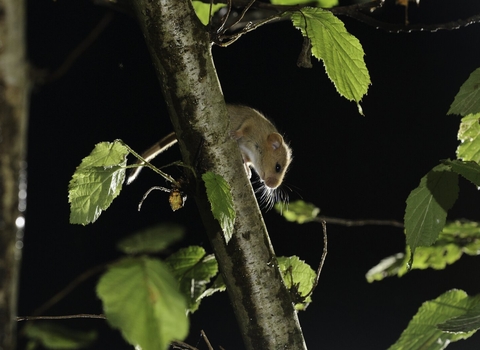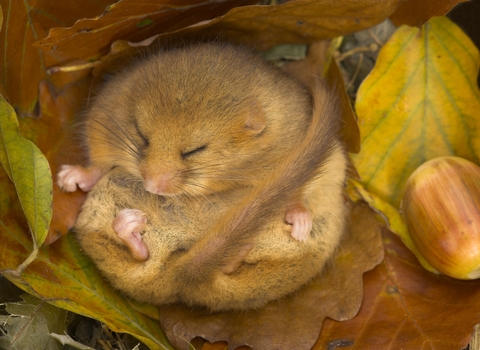
Young hazel dormouse by Terry Whittaker/2020VISION

©Danny Green
Hazel dormouse
Scientific name
Muscardinus avellanariusWhen to see
April to OctoberSpecies information
Category
Statistics
Length: 6-9cmTail: 5.7-6.8cm
Weight: 15-40g
Average lifespan: 5 years
About
Dormice are barely ever seen due to the fact they spend most of the day asleep! At night they come alive, climbing high into the trees on the hunt for a tasty snack. Their favourite foods are hazelnuts, berries and insects. Dormice build nests out of grass and leaves ready for the female to give birth to up to seven young. In autumn, dormice start looking for the perfect spot to hibernate for winter. They often choose to sleep in logs or leaves at the base of trees or just beneath the ground where they can avoid the winter cold.How to identify
The hazel dormouse has gingery-brown fur, large black eyes and a long, fluffy tail; it is much smaller than a squirrel.Distribution
Mainly found in southern England and Wales.In our area
As autumn sets in, dormice become more active as they desperately need to eat enough food to gain the weight that will help them survive hibernation. Having spent much of their summer resting, sleeping and breeding, they then go onto spend most their waking hours eating the abundant nuts and berries supplied by hazel trees, beeches, brambles and hawthorns. Sadly, without gaining that weight, dormice won’t survive hibernation and it is estimated that half of dormice die during their winter slumber.
There are dormice nest box monitoring schemes on a number of our nature reserves, including Harton Hollow, Brook Vessons and Hope Valley. These are all nature reserves managed to benefit the growth of the essential food plants like hazel trees that can sustain a dormouse population. The nest box schemes not only provide safe summer nesting sites for dormice to rear their young, they also allow us to check on the health of local dormice. These small rodents (which are more closely related to squirrels than true mice (wood mice and house mice being examples) live in low density and spend much of their active time hidden away from humans, so nest boxes are key to us finding out whether there are still dormice in an area and to see how their numbers increase or decrease year on year.
Did you know?
Hazel dormice, like many of our other small animals, hibernate through the winter months in order to survive. If food is scarce outside of hibernation season, they can save energy by dropping their body temperature and going into a state of 'torpor'. In fact, dormice can spend nearly three-quarters of the year 'asleep' in some form!As autumn sets in, dormice become more active as they desperately need to eat enough food to gain the weight that will help them survive hibernation. Having spent much of their summer resting, sleeping and breeding, they then go onto spend most their waking hours eating the abundant nuts and berries supplied by hazel trees, beeches, brambles and hawthorns. Sadly, without gaining that weight, dormice won’t survive hibernation and it is estimated that half of dormice die during their winter slumber.
There are dormice nest box monitoring schemes on a number of our nature reserves, including Harton Hollow, Brook Vessons and Hope Valley. These are all nature reserves managed to benefit the growth of the essential food plants like hazel trees that can sustain a dormouse population. The nest box schemes not only provide safe summer nesting sites for dormice to rear their young, they also allow us to check on the health of local dormice. These small rodents (which are more closely related to squirrels than true mice (wood mice and house mice being examples) live in low density and spend much of their active time hidden away from humans, so nest boxes are key to us finding out whether there are still dormice in an area and to see how their numbers increase or decrease year on year.
